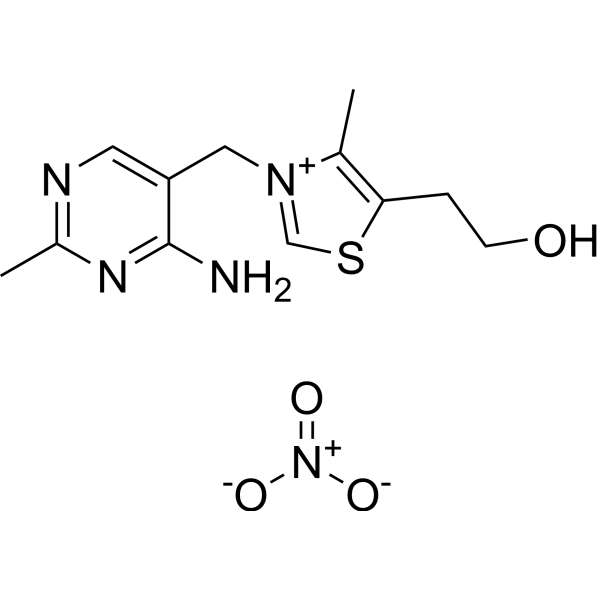
Thiamine nitrate
CAS No. 532-43-4
Thiamine nitrate( Vitamin B1 nitrate )
Catalog No. M26582 CAS No. 532-43-4
Thiamine nitrate is an essential vitamin, and can enhance normal neuronal actives.
Purity : >98% (HPLC)
 COA
COA
 Datasheet
Datasheet
 HNMR
HNMR
 HPLC
HPLC
 MSDS
MSDS
 Handing Instructions
Handing Instructions
| Size | Price / USD | Stock | Quantity |
| 500MG | 35 | In Stock |


|
| 1G | Get Quote | In Stock |


|
Biological Information
-
Product NameThiamine nitrate
-
NoteResearch use only, not for human use.
-
Brief DescriptionThiamine nitrate is an essential vitamin, and can enhance normal neuronal actives.
-
DescriptionThiamine nitrate is an essential vitamin, and can enhance normal neuronal actives.(In Vitro):In the blood of homozygous KO and KI mice ,Thiamine levels fed a conventional diet are decreased to 0.058±0.051 and 0.126±0.092 μM, respectively, at 7 weeks compare to WT mice (0.796±0.259 μM). When WT and homozygous KO and KI mice are fed a Thiamine-restricted diet (Thiamine: 0.60 mg/100 g food), blood Thiamine concentration at 5 and 14 days is markedly decreased to 0.010±0.009 and 0.010±0.006 μM, respectively, compare to WT mice (0.609±0.288 μM). Thiamine concentration in brain homogenate of WT mice fed a conventional diet is 3.81±2.18 nmol/g wet weight, and that of KO and KI is 1.33±0.96 and 2.16±1.55 nmol/g wet weight, respectively. Notably, Thiamine concentration in brain homogenate decreases steadily in KO and KI mice fed a thiamine-restrict diet (Thiamine: 0.60 mg/100 g food) for 5 days (0.95±0.72 nmol/g wet weight) and 14 days (1.11±0.24 nmol/g wet weight), respectively, compare to WT (3.65±1.02 nmol/g wet weight), before the mice presenting an phenotype of disease.
-
In VitroThiamine levels in the blood of homozygous KO and KI mice fed a conventional diet are decreased to 0.058±0.051 and 0.126±0.092 μM, respectively, at 7 weeks compare to WT mice (0.796±0.259 μM). When WT and homozygous KO and KI mice are fed a Thiamine-restricted diet (Thiamine: 0.60 mg/100 g food), blood Thiamine concentration at 5 and 14 days is markedly decreased to 0.010±0.009 and 0.010±0.006 μM, respectively, compare to WT mice (0.609±0.288 μM). Thiamine concentration in brain homogenate of WT mice fed a conventional diet is 3.81±2.18 nmol/g wet weight, and that of KO and KI is 1.33±0.96 and 2.16±1.55 nmol/g wet weight, respectively. Notably, Thiamine concentration in brain homogenate decreases steadily in KO and KI mice fed a thiamine-restrict diet (Thiamine: 0.60 mg/100 g food) for 5 days (0.95±0.72 nmol/g wet weight) and 14 days (1.11±0.24 nmol/g wet weight), respectively, compare to WT (3.65±1.02 nmol/g wet weight), before the mice presenting an phenotype of disease.
-
In VivoWT, homozygous, and heterozygous KO and KI mice fed a conventional diet (thiamine: 1.71 mg/100 g) survive for over 6 months without any phenotype of disease. Homozygous KO and KI mice fed a Thiamine-restricted diet (thiamine: 0.60 mg/100 g food) show paralysis, weight loss, and immobility, and die within 12 and 30 days, respectively. Similarly, homozygous KO and KI mice fed a Thiamine-restricted diet with an even lower percentage of Thiamine (Thiamine: 0.27 mg/100 g food) die within 14 and 18 days, respectively. However, WT and heterozygous KO and KI mice fed a Thiamine-restricted diet (Thiamine: 0.60 mg or 0.27 mg/100g food) survive for over 6 months without any phenotype of disease.
-
SynonymsVitamin B1 nitrate
-
PathwayOthers
-
TargetOther Targets
-
RecptorApoptosis| Caspase| p53| topoisomerase II| XIAP
-
Research Area——
-
Indication——
Chemical Information
-
CAS Number532-43-4
-
Formula Weight327.36
-
Molecular FormulaC12H17N5O4S
-
Purity>98% (HPLC)
-
SolubilityIn Vitro:?DMSO : 20 mg/mL (61.09 mM)
-
SMILES[O-][N+]([O-])=O.Cc1c(CCO)sc[n+]1Cc1cnc(C)nc1N
-
Chemical Name——
Shipping & Storage Information
-
Storage(-20℃)
-
ShippingWith Ice Pack
-
Stability≥ 2 years
Reference
1.Mahoney S, et al. The effects of phenoxodiol on the cell cycle of prostate cancer cell lines. Cancer Cell Int. 2014 Nov 8;14(1):110.
molnova catalog



related products
-
Pro-TGF-a
Pro-TGF-a
-
ETHYL 2-AMINO-4-METH...
ETHYL 2-AMINO-4-METHYL-5-PHENYLTHIOPHENE-3-CARBOXYLATE targets the prostaglandin E2 receptor EP2 subtype (human).
-
ZLD1039
ZLD1039 is a potent, orally bioavailable EZH2 (Enhancer of Zeste Homolog 2) inhibitor with high selectivity.



 Cart
Cart
 sales@molnova.com
sales@molnova.com


